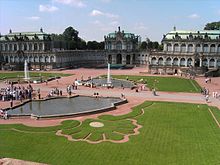- Mathematisch-Physikalischer Salon
-
The Mathematisch-Physikalischer Salon (English: Royal Cabinet of Mathematical and Physical Instruments) in Dresden, Germany, is a museum of the Staatliche Kunstsammlungen Dresden (State Art Collections). It is located in the Zwinger.
The Mathematisch-Physikalischer Salon accommodates on of the most significant collections of around 2,000 clocks and fine mechanical instruments. Some of the collection’s highlights are the Arabian celestial globe of 1279, a calculating machine of around 1650 once belonging to Blaise Pascal and the orbit clock manufactured in the 1560s by order of the court of Dresden.
Contents
History of the Mathematisch-Physikalischer Salon
The roots of the Mathematisch-Physikalischer Salon go back to the 15th century. Albrecht der Beherzigte (Albrecht the heartily) established the Herzoglische Harnischkammer (ducal armour chamber) at the Duke’s residence in Dresden. Later it became the Kurfürstliche Rüst- und Harnischkammer (electoral munition and armour chamber). It was used for storing the personal, tournament and parade weapons and associated equipment of the court.
Elector August of Saxony purposefully started to collect objects of art and for a time stored them in the munition and armour chamber. Already in the 16th century the collection had reached a similar size to that of the imperial armoury in Vienna. The elector combined the Kurfürstliche Rüst- und Harnischkammer and the Jagdkammer (hunting chamber) to the Kurfürstliche Rüstkammer (electorial munition chamber).
In 1724 the mathematical and physical instruments were separated from the munition chamber and other collections of the elector and stored in the newly established “Königliches Cabinet der mathematischen und physikalischen Instrumente” (royal cabinet of mathematical and physical instruments). Until 1746 this was the official name of the collection which concentrated on instruments for measuring length, temperature, weight, volume and time. Since 1728 the royal cabinet can be found in the Zwinger. The first residence of the cabinet was the pavilion of the carillon in the Dresden Zwinger. In 1746 the collection was removed to a part of the building which is today called pavilion F, and is still housed there. Since that time it is called the Mathematisch-Physikalischer Salon.
In 1784, an observatory was founded at the Mathematisch-Physikalischer Salon.
Library of the Mathematisch-Physikalischer Salon
The electoral library (later the regional library of Saxony) was founded in 1556. In connection to the foundation of the Königliches Cabinet der mathematischen und physikalischen Instrumente, at first, special documents corresponding to the objects in the collection were stored. Additionally, some standard works to the topics of the collection and similar topics were bought. In connection with the foundation of the observatory at the Mathematisch-Physikalischer Salon in 1784 the history of astronomy and their corresponding scientific instruments were the main focus for the further improvement of the library. During the middle part of the 19th century, purposeful purchase of literature led to a continuous enlargement of the library. Also, the collection was increased by the addition of books on the topics of history of time measurement, calculation machines and optical and physical instruments. Additionally, a lot of donations were made which add to the amount of literature included today.
World War II affected the collection and the library of the Mathematisch-Physikalischer Salon. Many objects and texts were removed to castles and manors of the Third Reich. Precious prints from the older inventory of the library were lost. After the reconstruction of the Zwinger at the beginning of the 1950s, the library went back to its previous home there.
Currently, the inventory of the library contains 896 monographs of which 25 are from the 17th century. 91 monographs are from the 18th century and 779 from the 19th century.
Today's presentation
Today, the Mathematisch-Physikalischer Salon in Dresden is one of the most famous collections of clocks and geodetic instruments.
Due to a general reconstruction of the Zwinger, the museum of sciences is currently closed. Its reopening is scheduled for spring 2013.[1]
References and notes
- ^ Information updated on 9th November 2011
External links
- Mathematisch-Physikalischer Salon at Staatliche Kunstsammlungen Dresden
- Mathematisch-Physikalischer Salon - Information and history from Dresden & Saxony tourism site (German)
This article uses content from the article Mathematisch-Physikalischer_Salon/en at Watch-Wiki, which is published under the GNU Free Documentation Licence. In Watch-Wiki there is a list of authors available.
Categories:- Horological museums in Germany
- Museums in Dresden
Wikimedia Foundation. 2010.


